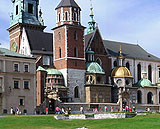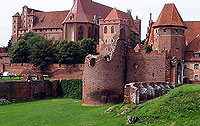UNESCO
 Poland has a rich and remarkable history. Artists and architects from all over the world constructed castles, churches and monasteries, which lead to the creation and expansion of cities. Many of these places have can be found on the UNESCO World Heritage List.
Poland has a rich and remarkable history. Artists and architects from all over the world constructed castles, churches and monasteries, which lead to the creation and expansion of cities. Many of these places have can be found on the UNESCO World Heritage List.
CRAKOW
The richly historic city of Cracow, a former capital of Poland, is located right next to the Royal Wawel Castle. Europe’s largest market square is found in this 13th-century merchant’s town, which contains several historical houses, palaces, churches and splendid interiors.
 The city’s fascinating history can be further seen through the remnants of the 14th century Kazimierz, filled with ancient synagogues, the Jaggelonian University in the centre of Krakow, and the Gothic cathedral where many kings of Poland are buried.
The city’s fascinating history can be further seen through the remnants of the 14th century Kazimierz, filled with ancient synagogues, the Jaggelonian University in the centre of Krakow, and the Gothic cathedral where many kings of Poland are buried.
WIELICZKA
 The famous old salt mine in Wieliczka has been active from the middle ages and still today. Today the mine is more like a labyrinth accessible by walkways up to 350 km and paths spread over 9 levels.
The famous old salt mine in Wieliczka has been active from the middle ages and still today. Today the mine is more like a labyrinth accessible by walkways up to 350 km and paths spread over 9 levels.
The Chapel of St. Kinga is extremely beautiful, with salt statues, carvings and decorations. The mine also contains lakes, a post office, restaurants and a movie theatre, and even tennis courts. The various rooms are used for concerts, balls, galas and theatre spectacles. One is also able to visit the sanatorium 211 metres underground, where people come to treat allergies and asthma.
KALWARIA ZEBRZYDOWSKA
Is a mannerist architectural park, a pilgrimage park and a landscape complex.
The park was built in the 17th century with the 16th century’s counter reformation which led to prosperity and the creation of Calvaries in Catholic Europe. It is the best known sanctuary in Poland, located near the town of Kalwaria Zebrzydowska.
WARSAW
During the Second World War Warsaw was almost totally destroyed by war activities. Many church towers, colourful streets and buildings, and a portion of the Royal Palace have been rebuilt since the War. Warsaw’s old city made the UNESCO World Heritage List as a large reconstruction with many remaining original fragments.
TORUN
Is the city in which Nicolas Copernicus was born. Torun is known for its extremely well kept old square from the middle ages and the connecting small streets. A unique feature is the Crooked Tower which was built in-between the XII and XIV ages, and stands like the famous Tower of Pisa.
ZAMOSC
Originating from the XVI century from the will of the powerful Jan Zamojski, it was in an Italian style. The Cathedral is well known, where visitors find rococo silver tabernacles.
MALBORK
 This World Heritage Site boasts the largest gothic fortress in Europe. The collection of castles contains the Tall Tower and Chapel of the Virgin Mary, the Middle Tower with the Dinning Hall, and the Low Tower with the armoury, weaponry tower, and draw bridge. One will also find a large museum collection of amber.
This World Heritage Site boasts the largest gothic fortress in Europe. The collection of castles contains the Tall Tower and Chapel of the Virgin Mary, the Middle Tower with the Dinning Hall, and the Low Tower with the armoury, weaponry tower, and draw bridge. One will also find a large museum collection of amber.
AUSCHWITZ-BIRKENAU
The largest German Nazi concentration camp from the Second World War. The Nazis killed many Jews, Poles, Romanians, and Russians. Currently the museum is open to visitors to see for the conditions for themselves.
PUSZCZA BIAŁOWIESKA
The oldest natural reservation site In Poland the largest natural observatory of forests in Europe, with unique details not be found in any other European forest, and rich flora and fauna. Various different types of forests are showcased here. The average age of the trees is 126 years. Puszcz is the habitat of many bison, which are the largest European mammals.











